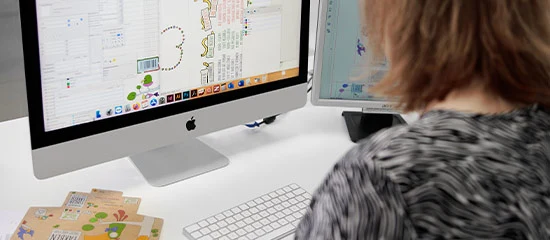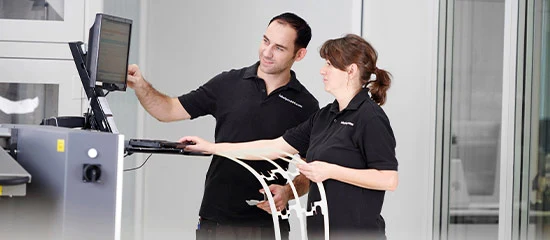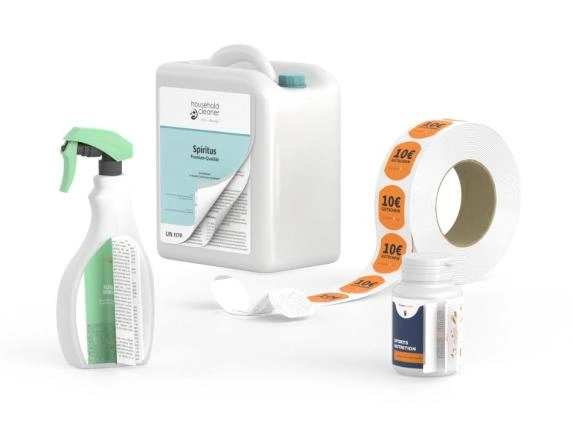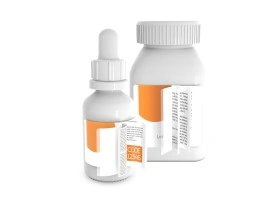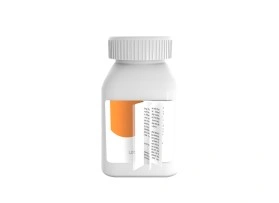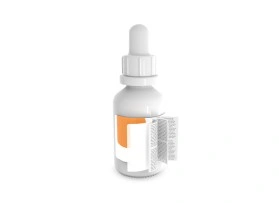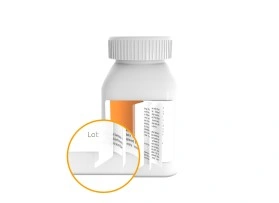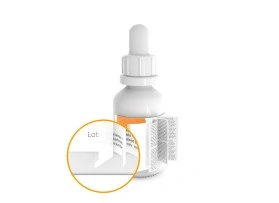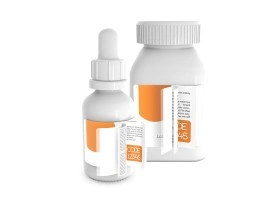Booklet labels
Are you looking for a Multi-layer label that is flexible in shape, design and application? A label as an alternative to a brochure or outer packaging? Booklet labels from Labelprint24.com mark your products individually and professionally.
- Fast production and free delivery
- Finishing with Film, Laminate, Lacquer, etc.
- State-of-the-art production for best quality
Discover the 2- and 3-sided printed Sandwich labels of Labelprint24.com!
- Production TimeFrom 10 days
- MaterialFilm / Paper
- Size100% customizable
- Finish OptionsFilm finishing / Varnish / Laminate
- Printing technologydigital and flexo
Select kind of product
Here you will find the entire range of labels.
1. Using booklet labels
- Booklet labels offer the most space of any label. As modern information carriers, they are labels and package leaflets in one.
- Booklet labels save product manufacturers and consumers from having to insert and read additional product brochures and packaging.
- Booklet labels are ideal tools for promotional campaigns and contests.
- Booklet labels are suitable for all types of packaging, enhancing its value, and flexible in terms of material and production method.
- They can be punched to custom shapes for use even on containers with difficult shapes or little available space.
- Booklet labels are becoming less expensive to produce and customise and their production can be affordable, even for smaller runs.
1.1. B2B industrial products
Booklet labels are the champions of the label market. In addition to the digital transition that has taken over label production, labels with multiple pages, such as booklet label (up to 24 printed pages) and sandwich/promotional labels (up to 3 printed pages) have become a major trend in the international packaging industry. Many products require instructions for correct use, warnings, safety precautions, and dosages. The packaging leaflet is supposed to remain with pharmaceutical and chemical products, but often ends up in the trash can or recycling together with the packaging. If it is firmly attached to the product in the form of a booklet label, this cannot happen. Information can also be offered in multiple languages, saving space on the external packaging. This way you will only need a single label for every region where the manufacturers sells its product.
Examples from the pharmaceutical and chemical industries where booklet labels are common:
- medications
- food supplements
- fertilisers
- pesticides
- cleaning agents, etc.
1.2. B2C marketing
Another typical application of booklet labels are marketing promotions, coupons, or sweepstakes that are attached over the long- or short term to promote a specific product or service or to create strong customer loyalty. This is one of the attractive features and added value of booklet labels that appeal to consumers. Use individual contest codes, recipe suggestions, or loyalty points to promote brand loyalty.
2. Types of booklet labels
When printing booklet label, there are important differences based on whether they are intended for flat or round containers. Due to the curvature of a round container, such as a bottle or beverage can, the format of the backing label may need to be shortened. This is the only way to ensure that the booklet label functions perfectly. These functions include secure adhesion, repeated resealing, and ease of applying the labels on the manufacturer's packaging line.
2.1 Booklet labels for round containers without grip tab
Booklet labels for round containers without a grip tab have a truncated base label. This is the only way that the multi-layer labels will stick securely to round or curved surfaces and prevent a displeasing popping up from the surface. These multi-layer labels do not have a grip tab to help with opening, but are instead opened at a perforation in the lamination or by means of a punched opening.
2.2. Booklet labels for round containers with grip tab
Booklet labels for round containers with a grip tab have a truncated base label. This is the only way that the multi-layer labels will stick securely to round or curved surfaces and prevent a displeasing popping up from the surface. These multi-layer labels have a tab on the transparent plastic backing label to allow for convenient opening and reclosing.
2.3. Booklet labels for flat containers without grip tab
Flat containers include all non-curved surfaces, such as a boxes or boxes. The base label can be up on all sides except for the adhesive side and still be laminated to the surface. These booklet labels do not have a grip tab to help with opening, but are instead opened at a perforation in the lamination or by means of a punched hole.
2.4. Booklet labels for flat containers with grip tab
Booklet labels for flat containers with a grip tab do not have a truncated base label. They adhere securely to all flat surfaces. For convenient opening and closing, these multi-layer labels have an additional grip tab on the transparent plastic backing label. Almost any format is possible.
2.5. Booklet labels with number code for flat and round containers
Booklet labels can be printed with serial number codes or from a database with numbers or codes. The promotional items are printed on page 2 or 3 of the backing label. Booklet labels with number codes are available for both flat as well as round containers. The format of booklet labels with number codes can be customised; round or unusual shapes are possible.
3. Production of booklet labels
There are many factors in the printing of booklet labels that affect their structure and other properties. These include the material used, the printing technology, the further processing (especially folding), as well as finishing and other production steps, such as customisation.
3.1. Structure of booklet labels
Booklet labels mainly consist of three parts: the self-adhesive backing label, the paper booklet itself with up to 24 pages, and a laminate film as the outer material. The first two parts are printed separately and then assembled with the laminate film into a booklet. As an inexpensive alternative, there are also booklet labels where the package insert is glued directly onto the backing label. In this variant, the laminate film is dispensed with and a perforation on the surface is necessary to allow the booklet to be opened.
3.2. The booklet
The paper booklet for the booklet label is produced by offset printing on sheets of label paper. After printing, up to 24 individual pages can be bound into a small book. In principle, printing is possible in any colour on the Euro scale as well as custom colours. The paper selection ranges from a very thin 60 g to a strong photographic paper at 135 g. After printing, the sheet is folded and glued into a booklet.
3.3. The backing label
The backing label for booklet labels consists of either a gloss or matte label paper or PP film and is printed on a roll bond in digital printing. The top side of the backing label covers the paper booklet. The underside is coated with a pressure sensitive adhesive, which is either permanently attached or removable. This side adheres to any surface. The digital printing of the backing label can be customised with individual data.
3.4. Printing and finishing
After the backing label and paper booklet are printed, the roll of labels can be further enhanced with coatings and hot plastic films. The paper booklet is then inserted into the second sticker. The booklet unit contains both parts of the booklet labels. This process requires high mechanical precision and is controlled by many sensors. After joining, the laminate film seals the booklet label and its finished shape is punched out. After printing, the booklet labels are rolled up around a carton core and prepared for shipping.
4. Applying booklet labels
The booklet labels are then applied with precision using a manual or automatic label dispenser like those used for normal roll labels. Assuming the booklet labels have been made properly, they can be applied without interruption and at high speed.

